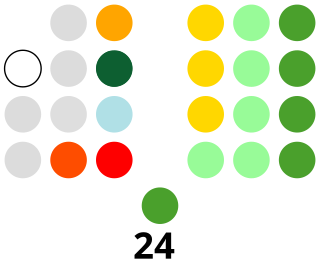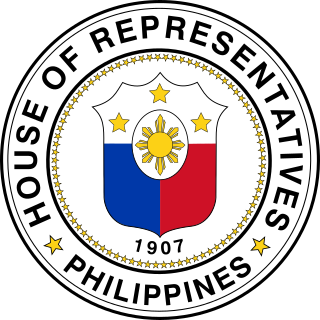
The Congress of the Philippines is the legislature of the national government of the Philippines. It is bicameral, composed of a lower body, the House of Representatives, although colloquially the term "Congress" commonly refers to just the latter, and an upper body, the Senate. The House of Representatives meets in the Batasang Pambansa in Quezon City while the Senate meets in the GSIS Building in Pasay.

The House of Representatives of the Philippines is the lower house of Congress, the bicameral legislature of the Philippines, with the Senate of the Philippines as the upper house. The lower house is usually called Congress, although the term collectively refers to both houses.

The Senate of the Philippines is the upper house of Congress of the bicameral legislature of the Philippines with the House of Representatives as the lower house. The Senate is composed of 24 senators who are elected at-large under plurality-at-large voting.
Elections in the Philippines are of several types. The president, vice-president, and the senators are elected for a six-year term, while the members of the House of Representatives, governors, vice-governors, members of the Sangguniang Panlalawigan, mayors, vice-mayors, members of the Sangguniang Panlungsod/members of the Sangguniang Bayan, barangay officials, and the members of the Sangguniang Kabataan are elected to serve for a three-year term.

The government of the Philippines has three interdependent branches: the legislative, executive, and judicial branches. The Philippines is governed as a unitary state under a presidential representative and democratic constitutional republic in which the president functions as both the head of state and the head of government of the country within a pluriform multi-party system.

The 7th Congress of the Philippines, composed of the Philippine Senate and House of Representatives, met from January 26, 1970, until September 23, 1972, during the fifth, sixth, and seventh years of Ferdinand Marcos's presidency. On September 23, 1972, President Marcos effectively dissolved the Congress with his declaration of martial law. Marcos then exercised legislative powers. In 1976, Congress was replaced by the Batasang Bayan as the Philippines' legislative body until 1978, when it was replaced by the Batasang Pambansa.
The legislative districts of Aklan are the representations of the province of Aklan in the various national legislatures of the Philippines. The province is currently represented in the lower house of the Congress of the Philippines through its first and second congressional districts.
The legislative districts of Agusan del Sur are the representations of the province of Agusan del Sur in the various national legislatures of the Philippines. The province is currently represented in the lower house of the Congress of the Philippines through its first and second congressional districts.
The legislative districts of Aurora are the representations of the province of Aurora in the various national legislatures of the Philippines. The province is currently represented in the lower house of the Congress of the Philippines through its lone congressional district.

The 12th Congress of the Philippines, composed of the Philippine Senate and House of Representatives, met from July 23, 2001, until June 4, 2004, during the first three years of Gloria Macapagal Arroyo's presidency. The convening of the 12th Congress followed the 2001 general elections, which replaced half of the Senate membership, and the entire membership of the House of Representatives.

The 8th Congress of the Philippines, composed of the Philippine Senate and House of Representatives, met from July 27, 1987, until June 17, 1992, during the presidency of Corazon Aquino. This was the first Congress after the ratification of the 1987 Constitution of the Philippines.

The legislative districts of Ilocos Norte are the representations of the province of Ilocos Norte in the various national legislatures of the Philippines. The province is currently represented in the lower house of the Congress of the Philippines through its first and second congressional districts.

The 11th Congress of the Philippines, composed of the Philippine Senate and House of Representatives, met from July 27, 1998, until June 8, 2001, during the 31-month presidency of Joseph Estrada and the first four months of Gloria Macapagal Arroyo's presidency. The convening of the 11th Congress followed the 1998 national elections, which replaced half of the Senate membership, and the entire membership of the House of Representatives. The Estrada impeachment was the highlight of the 11th Congress.
The legislative districts of Pampanga are the representations of the province of Pampanga and the highly urbanized city of Angeles in the various national legislatures of the Philippines. At present, the province and the city are represented in the House of Representatives of the Philippines by its four congressional districts.
The legislative districts of Nueva Ecija are the representations of the province of Nueva Ecija in the various national legislatures of the Philippines. The province is currently represented in the lower house of the Congress of the Philippines through its first, second, third, and fourth congressional districts.
The legislative districts of Palawan are the representations of the province of Palawan and the highly urbanized city of Puerto Princesa in the various national legislatures of the Philippines. The province and the city are currently represented in the lower house of the Congress of the Philippines through their first, second, and third congressional districts.
The legislative districts of the Philippines are the divisions of the Philippines' provinces and cities for representation in the various legislative bodies. Congressional districts are for House of Representatives, while there are districts for Sangguniang Panlalawigan, and some Sangguniang Panlungsod. For purposes of representation, the Senate, most Sangguniang Panlungsod, Sangguniang Bayan, Sangguniang Barangay and Sangguniang Kabataan are all elected at-large, although there were districts for the Senate from 1916 to 1935.

The Batasang Pambansa Complex, or simply the Batasan, is the seat of the House of Representatives of the Philippines. It is located along the Batasan Road in Batasan Hills, Quezon City.





